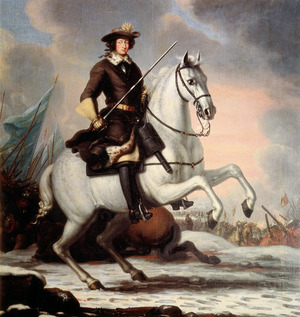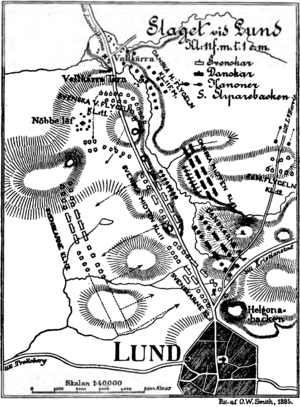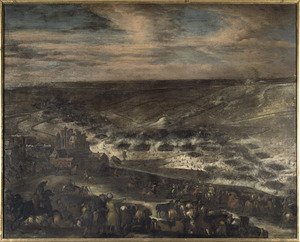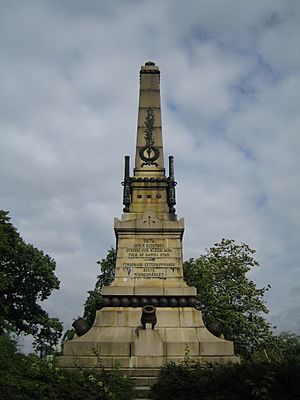Battle of Lund facts for kids
Quick facts for kids Battle of Lund |
|||||||
|---|---|---|---|---|---|---|---|
| Part of the Scanian War | |||||||
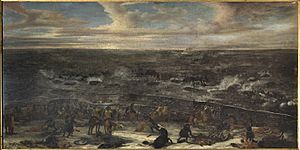 Battle of Lund by Johann Philip Lemke |
|||||||
|
|||||||
| Belligerents | |||||||
| Commanders and leaders | |||||||
| Strength | |||||||
|
8,000: 6,000 cavalry 12 cannon |
13,000: 6,000 cavalry 56 cannon |
||||||
| Casualties and losses | |||||||
|
3,000–4,000: 2,000–2,500 wounded 70 captured |
8,000–9,000: 4,000–4,500 wounded 2,000 captured |
||||||
The Battle of Lund was a very important and bloody fight during the Scanian War. It happened on December 4, 1676, near the city of Lund in southern Sweden. This battle was between the Danish army, led by their 31-year-old King Christian V of Denmark, and the Swedish army, led by their 21-year-old King Charles XI of Sweden.
The Danish army had about 13,000 soldiers. The Swedish army was smaller, with about 8,000 soldiers. This battle is known as one of the bloodiest in Scandinavia's history. A huge number of soldiers on both sides were killed or hurt.
Contents
Why the Battle Happened
After a big Swedish loss at the Battle of Fehrbellin, Sweden was busy trying to hold onto lands they controlled far away. This gave Denmark a chance to try and take back areas they had lost to Sweden. These lands, especially Scania, had become Swedish in 1658 after the Treaty of Roskilde.
Danish Invasion of Scania
In June 1676, the Danes invaded Sweden through Helsingborg. They had a large army of 14,000 men. Many local farmers helped the Danish army. This made it very hard for the smaller Swedish forces to defend the area. After only a month, almost all of Scania was back under Danish control. Only the strong town of Malmö remained Swedish.
Swedish Army Gathers
In August, the Danes tried to move north. But the young Swedish King Charles XI had been building a new army. This new army stopped the Danish advance at the Battle of Halmstad. By October, the Swedes had gathered 14,000 men. Most of these soldiers were cavalry, meaning they fought on horseback.
The Swedish army felt strong enough to march south. They slowly fought their way towards Malmö to try and help the city, which was under attack. However, getting supplies to the Swedish army was difficult. Local farmers, who supported the Danes, often stopped their supply wagons.
Armies Face Off at Lund
By early November, the Danish king and his army were camped near Lund. They were south of the Kävlinge River. The Danes controlled all the places where armies could cross the river. This meant the Swedish army had to camp on the north side.
This situation lasted for about a month. Then, in late November, snow began to fall. The river started to freeze. On December 3, a Swedish general told King Charles XI that the ice was strong enough to hold the army. The Danes thought the Swedes had settled down for winter and would not attack until spring.
The Battle Begins
Before the sun came up, the Swedish army quietly packed up their camp. They got ready to cross the frozen river. The Swedes had 2,000 foot soldiers (infantry) and 6,000 horse soldiers (cavalry). The Danish army was much larger. They had over 5,000 foot soldiers, 6,000 horse soldiers, and 1,300 Dutch marines. In total, the Danes had about 13,000 men.
Crossing the River in Secret
Between 4:00 AM and 5:30 AM, in the dark of night, the entire Swedish army crossed the river. They reached the other side without the Danes knowing. The Swedes planned to surprise the sleeping Danish camp with their cavalry. But their scouts reported that the ground between the armies was too rough for horses.
King Charles XI and his generals discussed what to do. Most of them thought it would be a bad idea to attack on foot. The Danes had many more foot soldiers. Also, the Swedes would lose their surprise if they marched a long way. The king wanted to attack right away, but he listened to his generals. He ordered his troops to move towards the hills north of Lund. This would give them a better position for their cavalry. The town of Lund would also protect their side.
The Danes React
By this time, the Danes had woken up. They quickly realized what the Swedes were doing. Both armies rushed to get control of the hills. The first small fight happened between the Swedish right side and the Danish left side. It ended without a clear winner. But the Swedes managed to take control of the hills. They pushed the Danes to the east.
Main Fight and Swedish Charge
The main battle started at 9:00 AM, when the sun rose. The fighting line stretched for about one kilometer. The Danes were on the east side, and the Swedes were on the west. The Danes had 56 cannons, which are big guns. The Swedes only had 12 smaller cannons.
King Charles XI personally led a charge to attack the Danish left side. During this fight, the Danish commander, Carl von Arensdorff, was badly hurt. By 10:00 AM, the entire Danish left side was forced to run away. This greatly weakened the Danish army. King Charles XI and his general, Simon Grundel Helmfelt, used their cavalry to chase the fleeing Danish soldiers. They cut down anyone who fell behind.
The chase went on for eight kilometers, all the way to the river. Some Danish officers tried to stop the Swedes. But many Danes were pushed onto the ice. The ice broke, and many of the remaining Danish soldiers drowned.
Danish Counterattack
While the Danish left side was running away, their right side was pushing the Swedes back. The Swedish left side broke apart. With Danish King Christian V gone and General Arensdorff wounded, his brother, Friedrich von Arensdorff, took command. The Danish army was now facing south. The Swedish forces were trapped with their backs against the town wall.
The situation was very bad for the Swedes. Their king, his cavalry, and the general had been gone for hours. The Swedes were also greatly outnumbered. They had about 1,400 foot soldiers and 2,500 horse soldiers. The Danes had about 4,500 foot soldiers and 2,100 horse soldiers. However, instead of pushing their attack, Friedrich von Arensdorff ordered his army to stop and regroup at noon. This pause gave the Swedes a small break.
King Charles XI Returns
At the river, the Swedish king was thinking about what to do next. He had little information from the town. What he heard suggested that the whole Danish army was running away. He was tempted to chase the fleeing Danish cavalry all the way to Landskrona. But he decided to return to Lund to help his army.
The battle at Lund started again. The Swedes were pushed back once more. At sunset, around 3:00 PM, the Swedish king returned from the north with his cavalry. He also had some cavalry units from the scattered Swedish left side. He decided to try and go around the Danish army from the west. His goal was to join the rest of the Swedish center. Danish commander Arensdorff decided to stop attacking the Swedish center. Instead, he turned to face the enemy cavalry in the northwest.
King Charles XI, two generals, and three guards broke through the Danish lines. They joined the smaller Swedish center. While Arensdorff was still attacking the cavalry in the north, the return of the Swedish king gave new energy to his tired troops. They attacked the Danish forces from behind.
Even though the Danes still had more soldiers (about 4,500 to 4,000 Swedes), Arensdorff had lost control. After half an hour, his army fell apart. Charles XI wanted to clear the battlefield of Danish soldiers. The remaining Danish cavalry quickly rode away into the night. A Danish general, Siegwert von Bibow, protected the foot soldiers as they retreated. But many Danes were killed. Finally, Field Marshal Helmfelt ordered the killing to stop. The Danish and Dutch soldiers who surrendered were saved. At 5:00 PM, the fighting ended.
What Happened After the Battle
The day after the battle, the bodies were counted. But the exact number of deaths is not known today. Some Swedish records say that between 8,300 and 9,000 bodies were buried. This number does not include Danes who drowned or soldiers who died from their wounds later. However, it's possible that the people burying the bodies made the numbers higher for money. One Danish record says 9,300 people died in total.
More realistic estimates say that between 3,000 and 4,000 men died on the battlefield. About 1,000 or a bit more of these were Swedes. The Swedes also had 2,000 men badly wounded. The Danish army had only about 5,000 soldiers who could still fight after the battle. At least 1,500 Danes were captured. The Dutch marines had a very hard time. Only a few dozen out of 1,300 survived. The battle was extremely bloody for both armies. Many soldiers were killed or hurt compared to the total number who fought.
The Swedish victory is often thought to be because of how their army was put together. They had fewer hired soldiers (mercenaries) than the Danish army. The Swedish mix of cavalry and infantry allowed them to quickly attack back when their foot soldiers were in trouble. The Danes still used an older cavalry tactic called the caracole. This made their cavalry slower and less agile.
The win at Lund greatly improved the Swedish army's spirits. King Charles XI was criticized for getting too carried away during the fight. But the battle made him very popular with his soldiers. The remaining Danish forces had to go back to the fortress of Landskrona. They would meet the Swedish army again at the Battle of Landskrona, after getting help from their allies.
See also
Images for kids
-
Hat worn by Charles XI of Sweden at the battle of Lund


